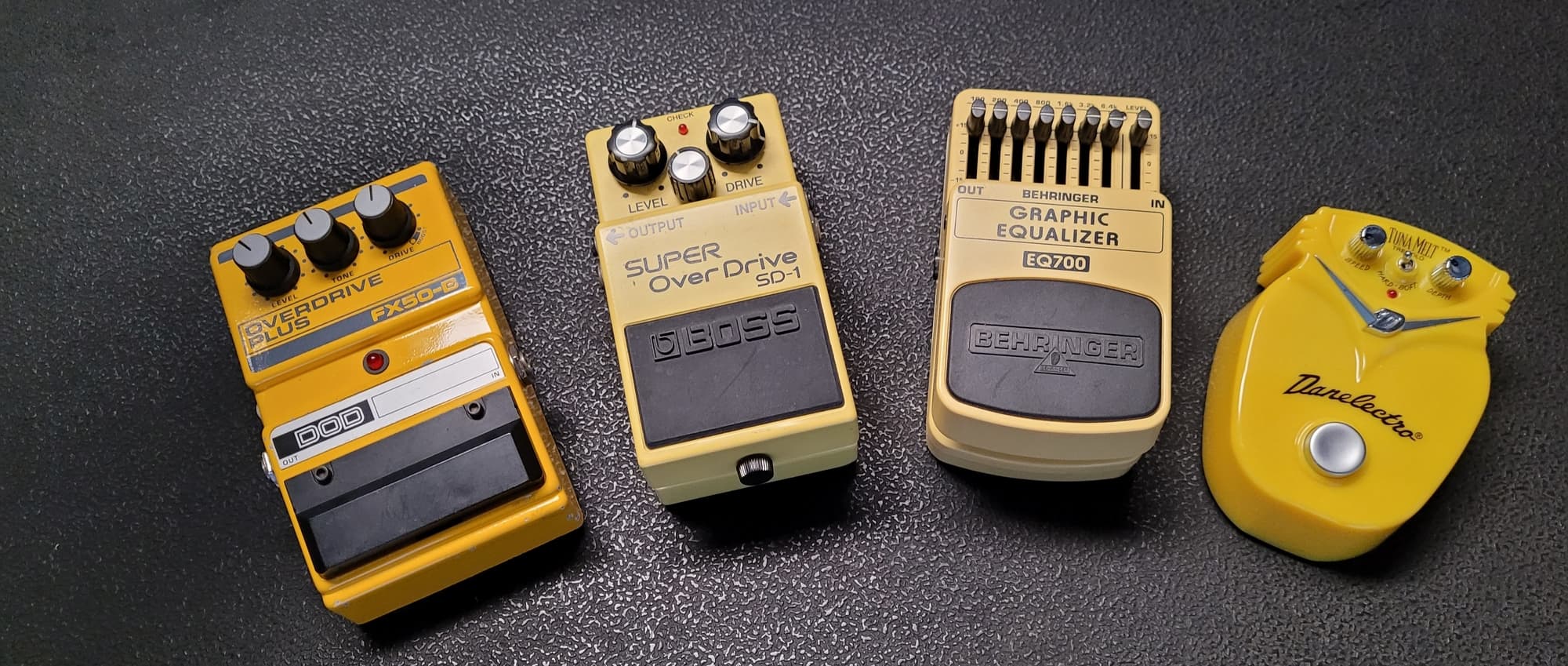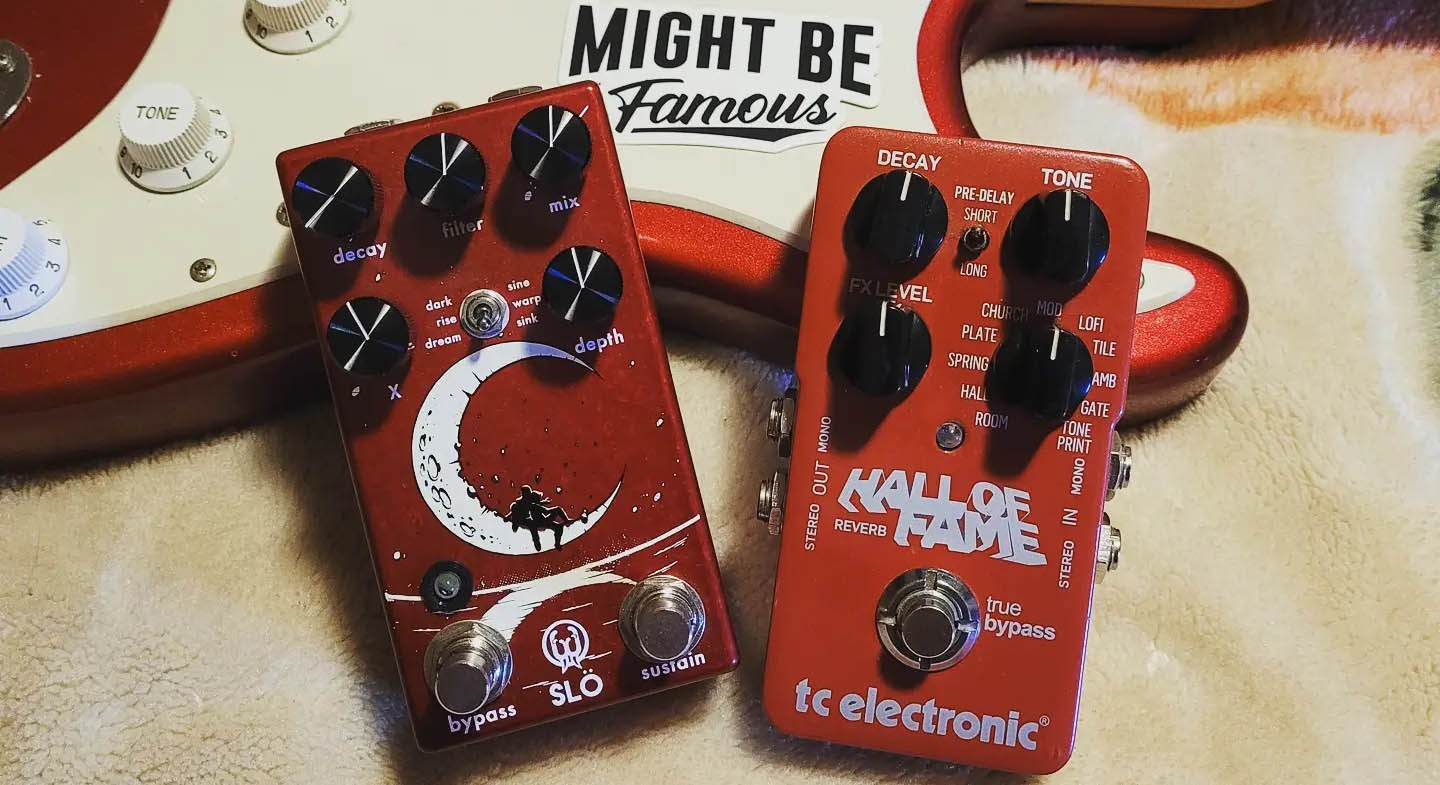If you’re looking to setup your first pedalboard, or possibly looking to rework your current rig, this guide will walk you through the process step by step.
At some point you will feel limited by your amps tone and will want to broaden your options. As soon as this happens it will likely be second nature to explore the different types of guitar pedals. Your first step will be to collect the appropriate effect pedals, then a board and accessories to setup the board, followed by putting your pedals in the correct order to get the best tone. Each one of these steps is important but if you’d like to skip around feel free to do so by using the table on contents below.
Table of Contents
- Which Pedals Should I Start With?
- Choosing a Pedalboard
- Connecting Your FX Boxes
- Setting Up Your Pedal Order
In this next section we will be walking you though some of the most essential pedals that you should consider before setting up your board. If you don’t currently own one or a number of these effects you might want to consider leaving a space for them on your board so that you can add them later.
Which Guitar Pedals Should I Start With?

While there are a number of amazing and complicated effects out there that you can explore, we have decided to keep it simple and stick with the basics. The following are some of the most popular staples that can be found on the rigs of smaller bands that have just started gigging to seasoned pros.
Tuner
While it might not be the most exciting pedal it is essential to any serious players setup. A tuner pedal can make or break your performance. If you’re not in tune nothing else matters. The two pedals that you will find on most top tuner pedal lists is the BOSS TU-3 or the TC Electronic PolyTone. These are both well-made and precise.
Distortion
No Rig is complete without a distortion pedal. Even those who have a well-built amp or are using software to run though their computer may will likely be tempted to switch to the clean channel and rip using some one of these tailored distortions. Distortion pedals can be used used for a variety of genres such as metal, punk, alternative rock, country, and so on. You will want to find the right kind of distortion stomp box for the type of music, or sound that you’re looking for. Here are a few favorites that you should try.
- BOSS DS-1
- BOSS Metal Zone
- DOD Gunsling
Overdrive
There seems to be lots of confusion for new players when it comes to overdrive. Do you really need one if you have a distortion pedal? Simply put, overdrive delivers low-gain giving you a crunchy edge, where distortion provides a more dirty sound. There are a plethora of options when exploring models. Some of the more popular include:
- Ibanez Tube Screamer
- BOSS SUPER OverDrive SD-1
- Electro Harmonix Soul Food
- Fulltone OCD
Chorus
Used often in rock, this is an incredibly useful tool when used correctly. A chorus can help bring energy to a dry and lifeless clean tone. They can be good to mix into leads, solos, and rhythm tones to add character.
This pedal is grouped in the modulation family, which also includes the flanger, phaser, and tremolo. If you’d like to get an idea of how a chorus pedal sounds listen to Nirvana’s “Come As you Are” main riff.
A few options you might consider include:
- BOSS CH-1
- MXR M234 or M83
- Dunlop M148
Wah Pedal
If you haven’t tried a WAH pedal you will be in for a treat. These pedals have been used by legends such as Jimi Hendrix, Stevie Ray Vaughan, Eric Clapton, and many others. It is a type of FX that some might describe as mimicking the human voice by saying the onomatopoeic name “wah-wah” as you sweep your foot back and forth on a rocking plate. This fun little pedal can become one of the most expressive effects on your pedal board.
One of the most popular is the Jim Dunlop model but additional options to consider include:
- Xotic Effeccts
- Vox V845 or V847-A
- Electro-Harmonix Wailer
- Morley Steve Vai Bad Horsie 2
Reverb Pedals

Every good setup needs reverb, but not every setup needs a reverb pedal. When deciding your next purchase take a look at your current amp and check to see if it has reverb built-in. If it doesn’t you will want to consider buying a reverb pedal. These effects basically emulate the echo sound that you would hear in a large room. This is particularly useful when you are running clean tones.
Some of the more popular reverb sounds include spring, plate, and shimmer. Below are some of the top reverb pedals.
- TC Electric Hall of Fame
- Electro-Harmonix Holy Grail
- BOSS FRV1 Fender Reverb
- Walrus Audio SLO
Delay Pedal
Have you ever wanted to create that perfect solo that causes everyone in the room to pause for a second, stop what they are doing, and truly be mesmerized? This pedal won’t do all that without your help but it’s a start. A delay pedal allows you to repeat notes. While that might not sound exciting on it’s own, take a look at what artists such as U2 and Eddie Van Halen have done using this effect. Simply put, it is hard to ignore the importance of this FX.
A few popular choices to consider would include:
- BOSS DD3 or DD7
- TC Electric Flashback
- Might Be Famous Pure Delay (Echo Delay)
To learn more about delay pedals visit the Ultimate Guide To Delay Pedals.
Fuzz Pedal
If you’re a fan of rock music in general you have likely hear a Fuzz pedal on a number of songs. These pedals might be described as a distorted gritty-sounding effect or super-hairy tone. These pedals give off massive amounts of harmonic saturation using extreme clipping to turn your audio signal into a square wave. In plan English, it gives you a killer rock in roll sound.
You can learn more about these types of effects by checking out our guide To the best fuzz pedals.
Choosing a Pedalboard
Deciding which pedalboard to purchase begins size. Size matters because as your collection grows the real-estate on your pedalboard stays the same. This has always been my advice but it isn’t always practical for everyone. If you are in a small band that is gigging daily or throughout the week you might opt for a small or medium sized board. Those who are home hobbyist or studio musicians might opt for a larger size.
Brands
Some of the best ready made boards or panels can be found by a number of different brands, with many different designs, features, sizes, and price points. If money isn’t a concern for you, and the sky is the limit, you want the Schmidt Array. It is the best that money can buy but it is also bulky and heavy.
Your next best choice would be from the Pedaltrain brand line. A good choice with nothing that is over the top in terms of cost or weight. These are costly but have a solid construction, and offer a variety of case options.
Lastly, we can’t forget the reliable options from SKB. This brand offers a solid construction and a variety of case sizes. Good for both live performances or playing at home.
How Do I Powers My Guitar Pedals?
When you’re setting up power there are a few options. You can choose to use 9-volt batteries, daisy chain them together, or a dedicated power supply. If you are playing for enjoyment, and you’re not OCD about your tone, any of these methods might work well. If you’re looking to optimize your rig to get the best sounds, a fully isolated pedalboard power supply is critical. It can help to reduce the noise from your guitar signal.
There are a number of brands that manufacturer external power supply units. Some to consider include:
- Voodoo Lab
- MXR
- Tone City
- T-Rex
Connecting Your Pedals
Connecting your FX pedals is done using patch cables. A patch cable is basically a super short U-shaped cable used to connect one stomp box to the next. This allows for pedals to be placed close together and save space.
What Order Should I Place My Pedals?
There is no right or wrong way to set up an effect signal chain (the order of your pedals). There is, however, a rational way to setup your pedals that allows you to get what some might consider a more optimal tone. For new players, I would recommend starting with this setup and then experiment by moving pedals around to get the sound that you prefer.
A common effect chain might look like the following:
Guitar => Volume Pedal => Compressor => Wah Pedal => Overdrive => Distortion => Modulation (Chorus, Flanger, Phaser, etc) => Delay => Reverb => Amplifier
Related Reading